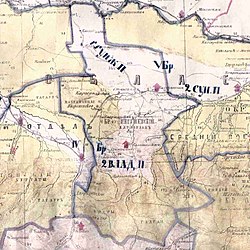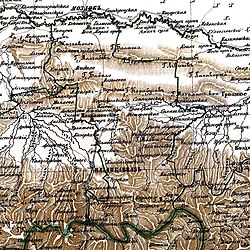Dattykh
Geography



The village is located on the left bank of the Fortanga river.
The nearest settlements: the village of Muzhichi in the west (less than 9 km in a straight line), the village of Galashki in the north-west (nearest by road).
History
Dattykh was founded in 1801 and is the ancestral village of the Bulguchevs and Korigovs (Upper Dattykh) and the Gandaloevs and Belkharoevs (Lower Dattykh). On the territory of the settlement, the remains of battle towers of representatives of these surnames have been preserved.
A well-known source of salt mining - Dattykh, located on the ground lyakh of the Karabulak society, served in the medieval period as the basis welfare of the Belkharoev family. In a later period, evaporated salt from this source was used by all Kists, all Ingush, all Karabulaks and part of Chechens.
In January 6th of 1851, in order to punish the highlanders for their insolence, Sleptsov gathered a detachment and under the command of Lieutenant Colonel Mezentsev made a punitive expedition on Dattykh, which has long been known as the nest of the most courageous robbers. The punitive expedition ended successful for the Russian Empire and the detachment continued cutting down forests.
In 1858, Naib of Little Chechnya Said-Dulla by order of Nikolay Yevdokimov made punitive raids on Shagot-Kokh, Dattykh, Azerze, Meredzhi and other villages, where many abreks were hiding.
Beginning in 1859, the Orstkhoys began to be evicted from all their mountain villages, including Dattykh. At the same time, on the site of the settlement, a Cossack village - Datykhskaya was founded.
In 1863, according to family lists, 33 families lived in Dattykh.
In 1865, all Karabulaks were evicted from the village, and among the Muhajirs left for the Ottoman Empire.
In 1875, with the permission of the military authorities, Dattykh began to be populated by the mountaineers from the Khamkhin and Tsorin societies, who rented the royal state land.
From 1944 to 1958, during the period of the deportation of Chechens and Ingush and the abolition of the Chechen-Ingush ASSR, the village was called Klyuchevoye. After the restoration of the Chechen-Ingush ASSRin 1958, the village was returned to its historical name - Dattykh.
Notes
References
- ^ Мальсагов 1963, p. 144.
- ^ Оздоев 1980, p. 830.
- ^ Кодзоев 2021, p. 105.
- ^ Барахоева, Кодзоев & Хайров 2016, p. 23.
- ^ Кодзоев & Киева 2021, p. 37.
- ^ Russian Federal State Statistics Service (2011). Всероссийская перепись населения 2010 года. Том 1 [2010 All-Russian Population Census, vol. 1]. Всероссийская перепись населения 2010 года [2010 All-Russia Population Census] (in Russian). Federal State Statistics Service.
- ^ "Таблица 5. Численность населения России, федеральных округов, субъектов Российской Федерации, городских округов, муниципальных районов, муниципальных округов, городских и сельских поселений, городских населенных пунктов, сельских населенных пунктов с населением 3000 человек и более". |Итоги Всероссийской переписи населения 2020 года
- ^ "Об исчислении времени". Официальный интернет-портал правовой информации (in Russian). 3 June 2011. Retrieved 19 January 2019.
- ^ Почта России. Информационно-вычислительный центр ОАСУ РПО. (Russian Post). Поиск объектов почтовой связи (Postal Objects Search) (in Russian)
- ^ "Закон Республики Ингушетия от 23 февраля 2009 года № 5-рз «Об установлении границ муниципальных образований Республики Ингушетия и наделении их статусом сельского поселения, муниципального района и городского округа»".
- ^ "Даттыхская сельский округ (сельсовет)* (Сунженский район)". Archived from the original on 2016-06-14.
- ^ Лист карты K-38-31-В-в — ФГУП «ГОСГИСЦЕНТР»
- ^ Волкова 1974, p. 166.
- ^ Ислам Текеев. "Сокровища Даттыха. Зачем в Ингушетии возрождают опустевшее горное село". 22 September 2020. stav.aif.ru
- ^ Ибрагимова 2009, p. 451.
- ^ Кавказцы или подвиги и жизнь замечательных лиц действовавших на Кавказе. Выпуски 1-12 (in Russian). СПб.: Тип. Якова Трея. 1857. p. 17.
- ^ Акты, собранные Кавказской археографической комиссией: Том XII (in Russian). Тифлис: Тип. Главного Управления Наместника Кавказского. 1904. p. 1116.
- ^ Посемейные списки жителей Карабулакского участка Ингушевского округа, составленные в 1864 г. и содержащие данные за 1863 г.
- ^ Рапорт Александра Нурид. ст. Ассиновская, 2 июня 1865 года
- ^ РСО-А. Ф. 20. ОН. 1. Д. 743. Л. 88-93 об.
- ^ "В Президиум Верховного Совета РСФСР. Президиум Верховного Совета Северо-Осетинской АССР просит утвердить его постановление о переименовании населённых пунктов в новых районах, вошедших в состав Северо-Осетинской АССР..." Archived from the original on 2018-08-30.
- ^ Ведомости Верховного Совета РСФСР, 1958, № 5.
Bibliography
- Мальсагов, З. К. (1963). Оздоева, Ф. (ed.). Грамматика ингушского языка [Grammar of the Ingush language] (in Ingush and Russian). Vol. 5 (2nd ed.). Грозный: Чечено-Ингушское Книжное Издательство. pp. 1–164.
- Оздоев, И. А. (1980). Оздоева, Ф. Г.; Куркиев, А. С. (eds.). Русско-ингушский словарь: 40 000 слов [Russian-Ingush dictionary: 40,000 words] (in Ingush and Russian). Москва: Русский язык. pp. 1–832.
- Кодзоев, Н. Д. (2021). Хайрова, Р. Р. (ed.). Русско-ингушский словарь [Russian-Ingush dictionary] (in Ingush and Russian). Ростов-на-Дону. pp. 1–656. ISBN 978-5-906785-55-8.
{{cite book}}: CS1 maint: location missing publisher (link) - Барахоева, Н. М.; Кодзоев, Н. Д.; Хайров, Б. А. (2016). Ингушско-русский словарь терминов [Ingush-Russian dictionary of terms] (in Ingush and Russian) (2 ed.). Нальчик: ООО «Тетраграф». pp. 1–288.
- Кодзоев, Н. Д.; Киева, З. Х. (2021). Накостхоев, Х. А.; Хайрова, Р. Р. (eds.). Ономастикон Ингушетии [Onomasticon of Ingushetia] (in Russian). Москва: ТПК «Центробланк». pp. 1–121. ISBN 978-5-91303-022-1.
- Волкова, Н. Г. (1974). Этнический состав населения Северного Кавказа в XVIII — начале XX века [Ethnic composition of the population of the North Caucasus in the 18th — early 20th centuries] (in Russian). Москва: Наука. pp. 1–276.
- Ибрагимова, З. Х. (2009). Царское прошлое чеченцев. Политика и экономика [The tsarist past of the Chechens. Politics and Economics.] (in Russian). Москва: ПРОБЕЛ-2000. pp. 1–872. ISBN 978-5-98604-150-6.



